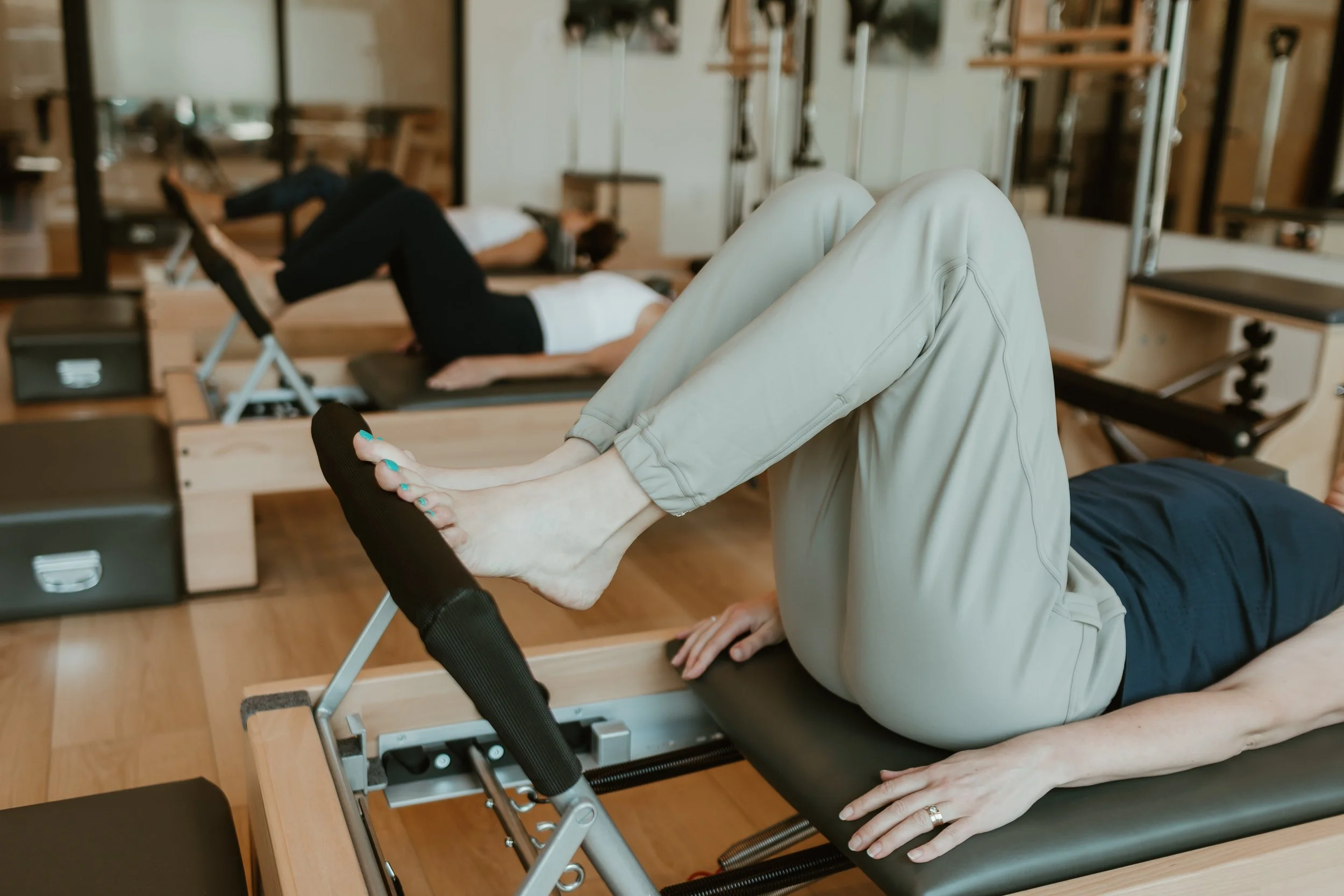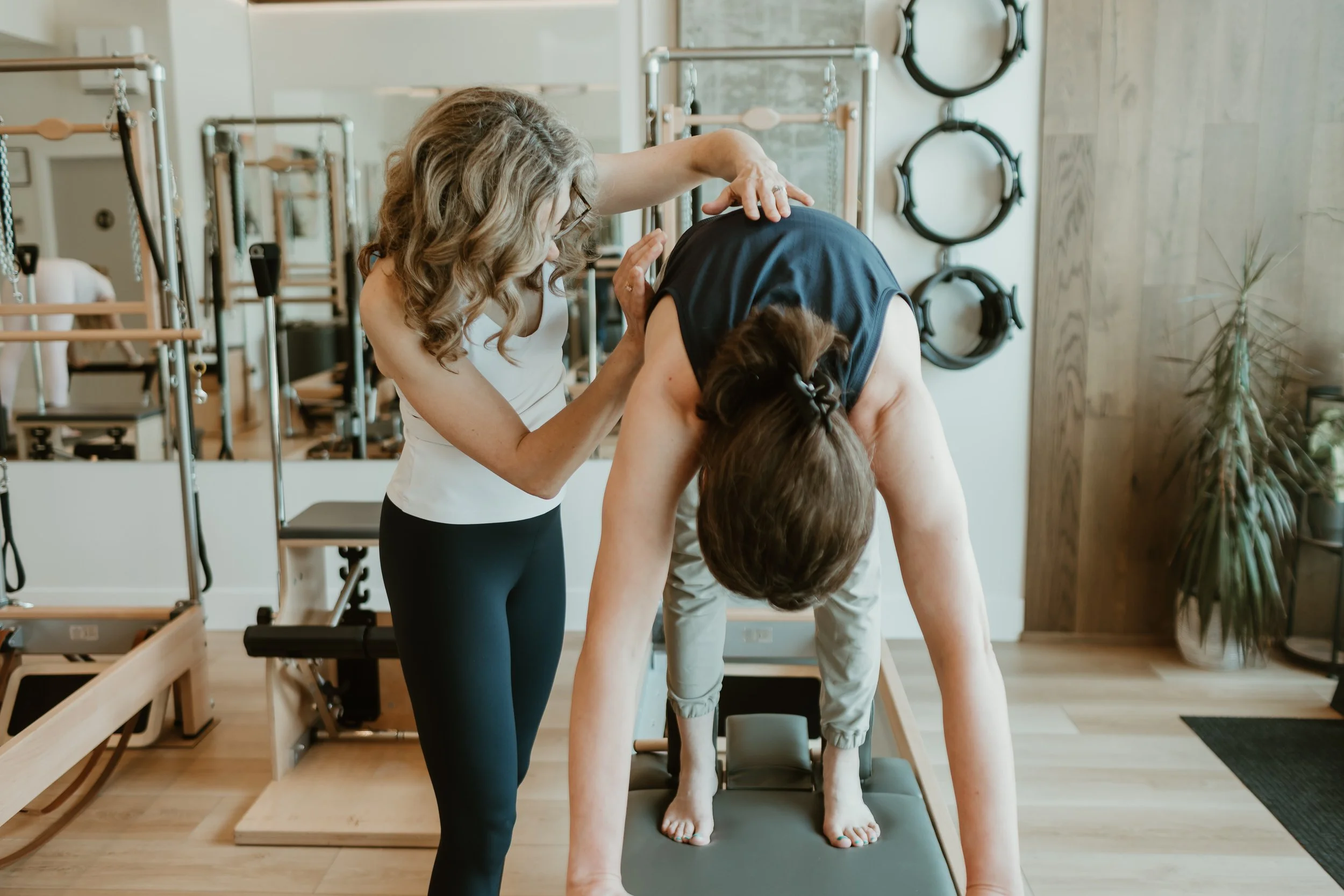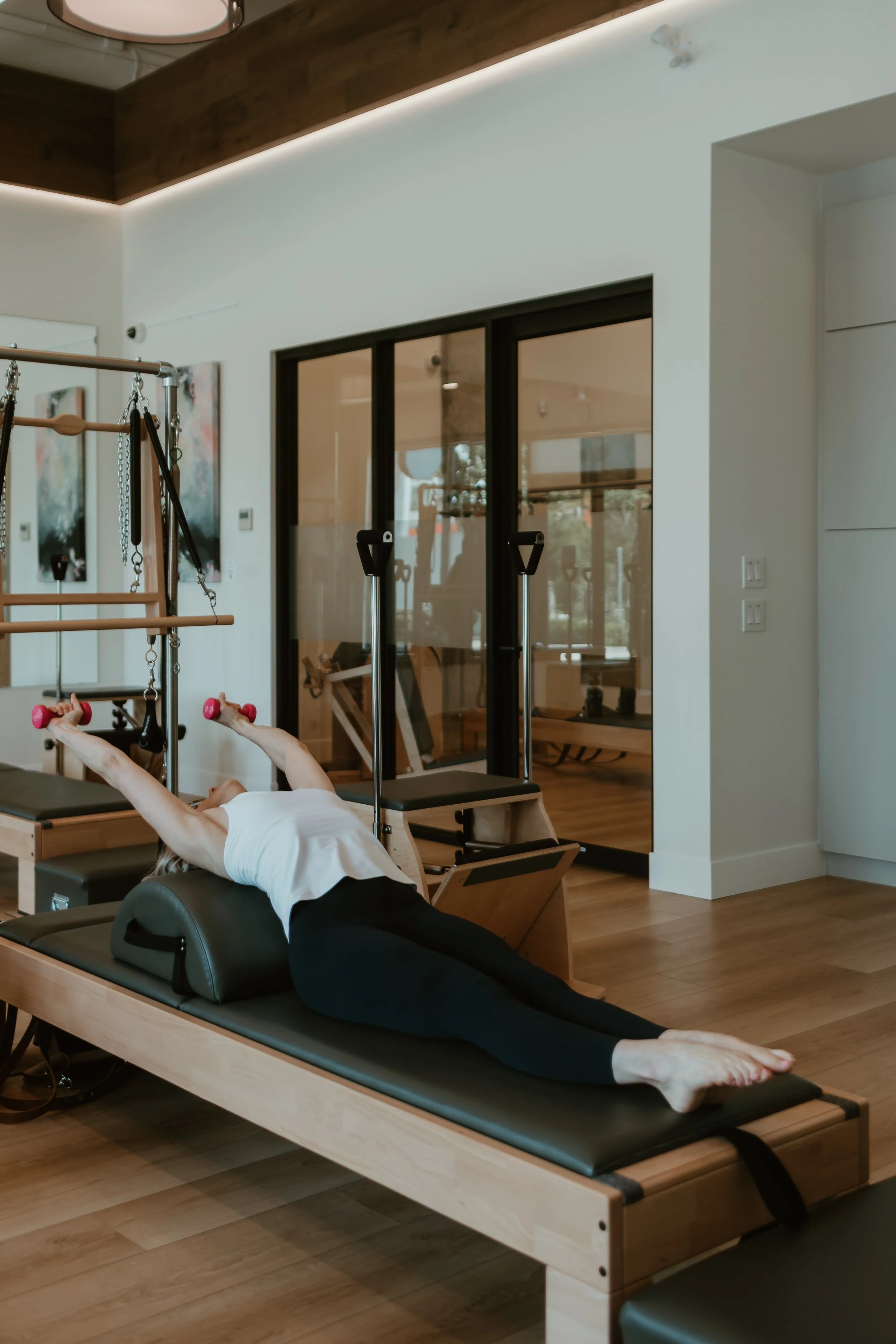Pilates as an Effective Rehabilitation Tool
The more I peruse social media, the more it causes me to reflect. The sheer amount of misinformation out there motivates me to promote scientific and evidenced-based health and fitness messages. Myths about needing a menopause specific training program, or a two week 6-pack ab series, or wall Pilates to gain that ultra-thin “Pilates body” that doesn’t exist.
First and foremost the message is simple: to improve health and reduce pain move your body intentionally every day. Thirty minutes is good, 60 minutes daily is better. The American College of Sports Medicine (ACSM) whose tagline is “Exercise is Medicine” compiled thousands of scientific data to advise a weekly formula for health:
Minimum of 150 minutes of moderate intensity cardiovascular activity (heart rate up to a minimum 50% of max)
At least 2 resistance training sessions (to strengthen muscles, joints, and bones)
1-2 sessions focusing on mobility, flexibility, and balance (to reduce falls and limit tightness that may cause poor movement patterns)
These guidelines are the minimums that have been shown time and again to promote health and longevity. As a movement educator for the past 26 years, these minimums are a little nuanced as there are certainly activities that are more beneficial than others, especially if someone has a particular goal. However, enjoyment also plays an important factor. Pick activities that you enjoy doing as studies show this brings more consistency. Being consistent is essential for any exercise program to be successful.
Photo credit: Meg Kristina Photography
Being in the fitness industry for such a long time, I have noticed a rise in chronic injuries and pain (Nahin et al.). This concerns me, and has shifted my focus, especially as a Pilates Teacher and kinesiologist. Our intentional workouts can also be rehab training. And I truly believe that is the beauty of Pilates. It’s a strengthening workout focused on preventive rehab and rehabilitation.
Preventive rehabilitation, or "pre-hab," uses targeted exercises to strengthen weak areas and improve overall physical function to prevent future injury or disease. Rehabilitation is a process that restores function, mobility, and strength to injured tissue.
Pilates was created by Joseph Pilates to be a low-impact exercise method suitable for everyone. The Pilates system is designed to:
develop the body uniformly (creating muscular balance around each joint)
correct wrong posture and movement patterns (that can lead to chronic pain and discomfort)
restore vitality (increasing our energy)
invigorate the mind (keeping us focused and sharp)
Because of Joseph’s focus on uniform development of the body, traditional Pilates has also demonstrated its effectiveness as a tool for rehabilitation. Traditional Pilates is the most studied, and needs to be distinguished from “fitness Pilates”. Fitness Pilates is often comprised of made-up moves, simply chasing the “burn” without much thought to intention or design. Traditional Pilates and Classical Pilates are methods that have been taught for the past hundred years, achieving the same amazing results time and again. In the traditional Pilates realm, instructors need at least 500 hours of teacher training that comes with a long 3-hour practical and written exam at the end. If successful, the teacher receives their certificate. With fitness Pilates, they often receive just a weekend course. This is an important distinction as traditional Pilates teachers, depending on the program, are often given the tools to help clients with most common ailments and issues.
Photo credit: Meg Kristina Photography
A systematic review titled “Is Pilates an Effective Rehabilitation Tool?” took the data of 23 studies to investigate traditional Pilates methods for rehabilitation of low back pain, ankylosing spondylitis (arthritis of the spine), multiple sclerosis, osteoporosis, scoliosis, hypertension, and chronic neck pain. The results of the review concur that Pilates as a rehabilitation tool was effective for achieving desired outcomes of healing, particularly in the area of reducing pain and disability (Byrnes et al.).
Low Back Pain (LBP)
Ten out of 14 studies in the above mentioned review found that Pilates performed better than the control or comparator group in helping with LBP (Byrnes et al.). Eight studies demonstrated that the Pilates group had a statistically significant decrease in pain and five of the studies reported statistically significant decrease in disability (Byrnes et al.). Developing the deep intrinsic core muscles has long been known to help reduce chronic low back pain. Transverse abdominis and multifidus act like a natural corset which provides essential support and stability to the pelvis and spine. One of Pilates main objectives is the activation and development of the stabilizing muscles.
Ankylosing Spondylitis
Ankylosing spondylitis is a type of arthritis and is characterized by long-term inflammation of the joints of the spine, typically where the spine joins the pelvis. One study compared 12 weeks of Pilates with three 60 minute weekly sessions lead by a certified teacher to a control group and found that Pilates resulted in significant improvements in functional daily movements (BASFI protocols) (Altan et al.). Another study using Pilates, along with two other rehab methods, also significantly improved conditions (Byrnes et al.). Key here is consistent gentle and intentional movement.
Multiple Sclerosis (MS)
Two studies within the above mentioned systematic review looked into Pilates for MS. One 8-week randomized control trial had a Pilates group lead by an experienced physiotherapist and Pilates instructor while the control group did abdominal breathing and exercises at home (Guclu-Gunduz et al.). Only the Pilates group lead by an instructor demonstrated significant improvements, whereas the control home group did not. Another 12-week study compared traditional Pilates to conventional physiotherapy and it was discovered that both were equally effective (Kalron et al.).
Osteoporosis
Concerning osteoporosis, both studies included in the above mentioned systematic review showed statistically significant improvements in pain and quality of life in the Pilates group when compared to the control and comparator group. One was a year-long randomized control trial comparing twice weekly 60 minute sessions of Pilates lead by a certified teacher to the control group doing Pilates at home. The comparator home group did show improvement too, just not as much as the Pilates teacher-lead group (Küçükçakır et al.). The other study was 24-weeks long, 3 weekly clinical 60 minute Pilates sessions lead by a physiotherapist trained in Pilates compared to the control group which did no exercise (Angın et al.). At the end of the study, the Pilates group bone mineral density scores were significantly higher, whereas the control group’s values decreased. The pain in the Pilates group decreased significantly (Angın et al.).
Scoliosis
One randomized control trial included in the systematic review demonstrated that those in the traditional Pilates group twice weekly 60 minutes sessions showed improvement in all three outcome measures: Cobb angle, trunk flexion, and pain, whereas the control group did not (Alves De Araújo et al.).
Hypertension
The one study included in the review found that the Pilates group demonstrated significant improvement in all outcome measures compared to the control group. Blood pressure also clinically decreased in the Pilates group. Most methods of physical activity have been shown to reduce hypertension and blood pressure.
Chronic Neck Pain
One randomized control trial discovered that Pilates Apparatus workouts compared to home-based exercises were more effective in outcome measures of pain, disability, and quality of life (Scollay, F. 2016). They found the comparator group of home exercises also improved, but not to the same degree as the Pilates group (Byrnes et al.).
I love reading research studies on Pilates, discovering what Pilates exercises and protocols the investigators used to help heal participants. This is why months ago we began to add 5-10 minutes of preventive rehabilitation activation work before we start every reformer class. And why we focus on effective strengthening Pilates exercises and protocols. There is a proven method to every sequence and exercise selection we teach.
With this focus we have also added additional Foundations classes on the schedule, where we program valuable foundational Pilates exercises which resemble rehabilitative work. Perfect for those newer to Pilates who want to nail down a particular Pilates exercise or a client needing support with a current injury or wanting to take the time to make important muscular activations to provide stability and support.
Let’s workout to build strength and endurance in our muscles and joints, correct movement patterns that best serve us for daily life and favourite sports, and help keep those painful chronic injuries at bay.
Resources
Angın, Ender, et al. “The Effects of Clinical Pilates Exercises on Bone Mineral Density, Physical Performance and Quality of Life of Women with Postmenopausal Osteoporosis.” Journal of Back and Musculoskeletal Rehabilitation, vol. 28, no. 4, Dec. 2015, pp. 849–58. DOI.org (Crossref), https://doi.org/10.3233/BMR-150604.
Alves De Araújo, Maria Erivânia, et al. “The Effectiveness of the Pilates Method: Reducing the Degree of Non-Structural Scoliosis, and Improving Flexibility and Pain in Female College Students.” Journal of Bodywork and Movement Therapies, vol. 16, no. 2, Apr. 2012, pp. 191–98. DOI.org (Crossref), https://doi.org/10.1016/j.jbmt.2011.04.002.
Nahin, Richard L., et al. “Estimated Rates of Incident and Persistent Chronic Pain Among US Adults, 2019-2020.” JAMA Network Open, vol. 6, no. 5, May 2023, p. e2313563. DOI.org (Crossref), https://doi.org/10.1001/jamanetworkopen.2023.13563.
Byrnes, Keira, et al. “Is Pilates an Effective Rehabilitation Tool? A Systematic Review.” Journal of Bodywork and Movement Therapies, vol. 22, no. 1, Jan. 2018, pp. 192–202. DOI.org (Crossref), https://doi.org/10.1016/j.jbmt.2017.04.008.
Kalron, Alon, et al. “Pilates Exercise Training vs. Physical Therapy for Improving Walking and Balance in People with Multiple Sclerosis: A Randomized Controlled Trial.” Clinical Rehabilitation, vol. 31, no. 3, Mar. 2017, pp. 319–28. DOI.org (Crossref), https://doi.org/10.1177/0269215516637202.
Guclu-Gunduz, Arzu, et al. “The Effects of Pilates on Balance, Mobility and Strength in Patients with Multiple Sclerosis.” NeuroRehabilitation: An International, Interdisciplinary Journal, vol. 34, no. 2, May 2014, pp. 337–42. DOI.org (Crossref), https://doi.org/10.3233/NRE-130957.
Altan, L., et al. “Effect of Pilates Training on People with Ankylosing Spondylitis.” Rheumatology International, vol. 32, no. 7, July 2012, pp. 2093–99. DOI.org (Crossref), https://doi.org/10.1007/s00296-011-1932-9.





